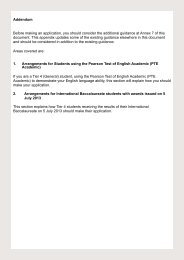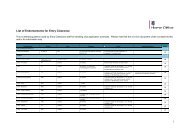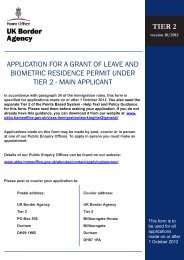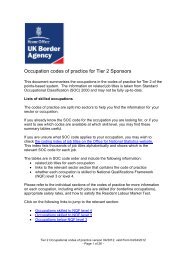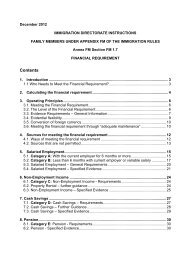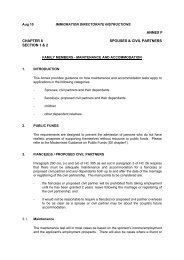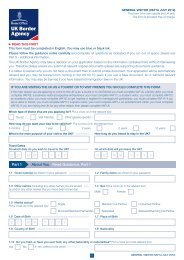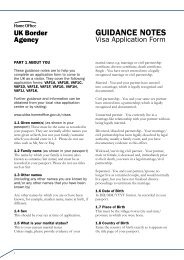Annex FM 2.0 Genuine and subsisting relationship - UK Border ...
Annex FM 2.0 Genuine and subsisting relationship - UK Border ...
Annex FM 2.0 Genuine and subsisting relationship - UK Border ...
You also want an ePaper? Increase the reach of your titles
YUMPU automatically turns print PDFs into web optimized ePapers that Google loves.
IMMIGRATION DIRECTORATE INSTRUCTIONS<br />
FAMILY MEMBERS UNDER APPENDIX <strong>FM</strong> OF THE IMMIGRATION RULES<br />
<strong>Annex</strong> <strong>FM</strong> Section <strong>FM</strong> <strong>2.0</strong><br />
<strong>Genuine</strong> <strong>and</strong> Subsisting Relationship<br />
An assessment of whether an applicant’s <strong>relationship</strong> with their partner is <strong>subsisting</strong><br />
(which was regarded as including whether a <strong>relationship</strong> was genuine) has always<br />
formed part of the consideration of an application by the <strong>UK</strong> <strong>Border</strong> Agency. This<br />
document replaces existing guidance <strong>and</strong> applies to any application under the<br />
Immigration Rules submitted before, on or after 9 July 2012, including under Part 8<br />
of the rules.<br />
SECTION CONTENTS<br />
1. Introduction<br />
<strong>2.0</strong> <strong>Genuine</strong> <strong>and</strong> <strong>subsisting</strong><br />
2.1. Leave to enter, leave to remain, further leave to remain <strong>and</strong> indefinite<br />
leave to remain applications.<br />
3.0 Assessment of whether a <strong>relationship</strong> is genuine <strong>and</strong> <strong>subsisting</strong><br />
3.1 Factors which may be associated with a genuine <strong>and</strong> <strong>subsisting</strong><br />
<strong>relationship</strong><br />
3.2 Factors which may be associated with a <strong>relationship</strong> which is not genuine<br />
<strong>and</strong> <strong>subsisting</strong><br />
<strong>Genuine</strong>ness of <strong>relationship</strong><br />
1
1.0 Introduction<br />
This section covers those who apply for leave to enter or remain or for indefinite<br />
leave to remain in the United Kingdom on the basis of family life with a person<br />
who is:<br />
• a British Citizen<br />
• settled in the <strong>UK</strong><br />
• in the <strong>UK</strong> with refugee leave or<br />
• in the <strong>UK</strong> with humanitarian protection<br />
<strong>and</strong> who is their partner. In this guidance the term ‘partner’ means the<br />
applicant’s fiancé(e), proposed civil partner, spouse, civil partner, unmarried<br />
partner or same sex partner, unless otherwise stated.<br />
In Appendix <strong>FM</strong>, an unmarried partner or a same sex partner means a person<br />
who has been living with the applicant in a <strong>relationship</strong> akin to a marriage or<br />
civil partnership for at least two years prior to the date of application.<br />
The following guidance provides factors that caseworkers must consider when<br />
assessing whether a <strong>relationship</strong> is genuine <strong>and</strong> <strong>subsisting</strong> <strong>and</strong> whether the<br />
requirements within the Immigration Rules have been met. A sham marriage<br />
<strong>and</strong> a forced marriage are not regarded as genuine <strong>and</strong> <strong>subsisting</strong> <strong>relationship</strong>s.<br />
<strong>2.0</strong> <strong>Genuine</strong> <strong>and</strong> <strong>subsisting</strong><br />
Family migration must be based on a genuine <strong>and</strong> <strong>subsisting</strong> <strong>relationship</strong>. An<br />
applicant <strong>and</strong> their partner must provide evidence that they are in a genuine<br />
<strong>and</strong> <strong>subsisting</strong> <strong>relationship</strong>.<br />
Caseworkers must consider the objective factors set out below when assessing<br />
an application for leave to enter, leave to remain or indefinite leave to remain in<br />
the United Kingdom. The outcome of an assessment may prompt additional<br />
scrutiny from caseworkers to identify <strong>and</strong> evidence a non-genuine, non<strong>subsisting</strong><br />
<strong>relationship</strong> (which may include a sham marriage or forced marriage)<br />
or, where indicated below, may result in an outright refusal.<br />
The list of factors to consider, set out below, is not to be considered as a<br />
checklist. Its purpose is to assist <strong>and</strong> focus consideration of whether an<br />
applicant meets the genuine <strong>and</strong> <strong>subsisting</strong> requirement.<br />
Decisions on whether a <strong>relationship</strong> is genuine <strong>and</strong> <strong>subsisting</strong> are to be<br />
considered as a whole, based on all the available evidence, on a case-bycase<br />
basis taking account of all the circumstances of the application.<br />
2.1 Leave to enter, leave to remain, further leave to remain <strong>and</strong> indefinite<br />
leave to remain applications<br />
Whether the <strong>relationship</strong> is ‘genuine <strong>and</strong> <strong>subsisting</strong>’ has to be considered at the<br />
2
entry clearance/leave to remain, further leave to remain <strong>and</strong> indefinite leave to<br />
remain stages of the immigration process. The factors will inform casework<br />
decisions across these stages, but some will be relevant to one stage (e.g. entry<br />
clearance/leave to remain) <strong>and</strong> not others, or more relevant to one stage than<br />
others.<br />
3.0 Assessment of whether a <strong>relationship</strong> is genuine <strong>and</strong> <strong>subsisting</strong><br />
Caseworkers must be alert <strong>and</strong> sensitive to the extent to which religious <strong>and</strong><br />
cultural practices may shape the factors present or absent in a particular case,<br />
particularly at the entry clearance/leave to remain stage. For example, a couple<br />
in an arranged marriage may have spent little if any time together prior to the<br />
marriage. For many faiths <strong>and</strong> cultures marriage marks the start of a<br />
commitment to a lifelong partnership <strong>and</strong> not the affirmation of a pre-existing<br />
partnership.<br />
Caseworkers must take into account normal practices for marriages <strong>and</strong> family<br />
living according to particular religious <strong>and</strong> cultural traditions when considering<br />
the factors present or absent in each case. In particular, evidence of pre-marital<br />
co-habitation <strong>and</strong> joint living arrangements can be a factor associated with a<br />
genuine <strong>relationship</strong>; equally, their absence can be too. In some cultures it is<br />
traditional for the household accounts, bills etc to be in the name of the male<br />
head of the household (who could be the male partner or their father or<br />
gr<strong>and</strong>father).<br />
Caseworkers have discretion to grant or refuse an application based on that<br />
overall assessment, regardless of whether one or more of the factors below is,<br />
or is not, present in the case. Consideration of whether a <strong>relationship</strong> is<br />
genuine <strong>and</strong> <strong>subsisting</strong> is not a checklist or tick-box exercise.<br />
In assessing whether a <strong>relationship</strong> is genuine <strong>and</strong> <strong>subsisting</strong>, consideration<br />
should be given to the following factors listed in section 3.1 <strong>and</strong> section 3.2,<br />
which are not exhaustive.<br />
3.1 Factors which may be associated with a genuine <strong>and</strong> <strong>subsisting</strong><br />
<strong>relationship</strong><br />
(i) The couple are in a current, long-term <strong>relationship</strong> <strong>and</strong> are able to provide<br />
satisfactory evidence of this.<br />
(ii) The couple have been or are co-habiting <strong>and</strong> are able to provide satisfactory<br />
evidence of this.<br />
(iii) The couple have children together (biological, adopted or step-children)<br />
<strong>and</strong> shared responsibility for them.<br />
(iv) The couple share financial responsibilities, e.g. a joint mortgage/tenancy<br />
agreement, a joint bank account <strong>and</strong>/or joint savings, utility bills in both their<br />
names.<br />
3
(v) The partner <strong>and</strong>/or applicant have visited the other’s home country <strong>and</strong><br />
family <strong>and</strong> are able to provide evidence of this. (The fact that an applicant<br />
has never visited the <strong>UK</strong> must not be regarded as a negative factor, but it is<br />
a requirement of the Immigration Rules that the couple have met in person).<br />
(vi) The couple, or their families acting on their behalf, have made definite plans<br />
concerning the practicalities of the couple living together in the <strong>UK</strong>. In the<br />
case of an arranged marriage, the couple both consent to the marriage <strong>and</strong><br />
agree with the plans made by their families.<br />
3.2 Factors which may be associated with a <strong>relationship</strong> which is not genuine<br />
<strong>and</strong> <strong>subsisting</strong><br />
If a case contains one or more of the factors listed below, this may prompt<br />
additional scrutiny of the application but will not necessarily result in a negative<br />
decision. Caseworkers must continue to look at the circumstances of the case<br />
as a whole.<br />
Even where additional scrutiny has been prompted by any of the following<br />
factors, it does not necessarily mean that the <strong>relationship</strong> is not genuine <strong>and</strong><br />
<strong>subsisting</strong>.<br />
The factors which may prompt additional scrutiny of an application include those<br />
listed below. Some factors may also, where specifically stated, lead to a refusal<br />
of an application without additional scrutiny but again, before deciding,<br />
caseworkers must continue to look at the circumstances as a whole:<br />
(i) If the marriage or civil partnership took place in the <strong>UK</strong>, a report – of a<br />
suspected sham marriage or civil partnership - was made by the registration<br />
service under section 24 of the Immigration <strong>and</strong> Asylum Act 1999.<br />
(ii) The applicant or partner makes a public statement that their marriage is a<br />
sham. An application can be refused on the basis of such a public statement<br />
alone.<br />
(iii) The applicant or partner makes a public statement (not in confidence) that<br />
they have been forced into marriage. An application can be refused on the<br />
basis of such a public statement alone.<br />
(iv) A sibling of the partner or applicant has been forced into marriage.<br />
(v) The applicant, partner or an immediate family member of either is or has<br />
been the subject or respondent of a forced marriage protection order under<br />
the Forced Marriage (Civil Protection) Act 1997 or the Forced Marriage etc<br />
(Protection <strong>and</strong> Jurisdiction) (Scotl<strong>and</strong>) Act 1999.<br />
An application can be refused on the basis alone of a current order involving<br />
the applicant or partner.<br />
(vi) There is evidence from a reliable third party (e.g. the Forced Marriage<br />
Unit, police, social services, registration service or a minister of religion)<br />
which indicates that the marriage is or may be a sham marriage or a<br />
4
forced marriage. (It may not be possible for this information to be used in<br />
any refusal notice). The fact that a third party indicates that in their opinion<br />
a marriage, partnership or <strong>relationship</strong> is genuine must not be afforded any<br />
weight.<br />
(vii) The applicant or partner does not appear to have the capacity to<br />
consent to the marriage, partnership or <strong>relationship</strong>, e.g. owing to learning<br />
difficulties, <strong>and</strong> independent evidence, e.g. from a social services<br />
assessment, has not been provided to confirm that such capacity exists.<br />
(viii) There is evidence of unreasonable restrictions being placed on the<br />
applicant or partner, e.g. being kept at home by their family, being subject<br />
to unreasonable financial restrictions, attempts to prevent the police or<br />
other agencies having reasonable, unrestricted access to the applicant or<br />
partner.<br />
(ix) Failure by the applicant or partner to attend an interview, without<br />
reasonable explanation, where required to do so to discuss the application<br />
or their welfare, or seeking to undermine the ability of the <strong>UK</strong> <strong>Border</strong><br />
Agency to arrange an interview, e.g. by unreasonable delaying tactics by<br />
the couple or a third party.<br />
(x) The couple are unable to provide any information about their intended living<br />
arrangements in the <strong>UK</strong> or about the practicalities of the applicant moving to<br />
the <strong>UK</strong>.<br />
(xi) The circumstances of the wedding ceremony or reception, e.g. no or few<br />
guests <strong>and</strong>/or no significant family members present.<br />
(xii) The couple are unable to provide accurate personal details about each<br />
other (e.g. name, age, nationality, employment, parent’s names <strong>and</strong> place of<br />
residence), provide inconsistent evidence, or do not have a shared<br />
underst<strong>and</strong>ing of the core facts of their <strong>relationship</strong>, e.g. how <strong>and</strong> where they<br />
met for the first time.<br />
(xiii) The couple are unable to communicate with each other in a language<br />
understood by them both.<br />
(xiv) There is evidence of money having been exchanged for the marriage to<br />
be contracted (unless this is part of a dowry).<br />
(xv) There is a lack of appropriate contribution to the responsibilities of the<br />
marriage, partnership or <strong>relationship</strong>, e.g. a lack of shared financial or other<br />
domestic responsibilities.<br />
(xvi) Matrimonial co-habitation is not maintained (except where one party is<br />
working or studying away from home) or there is no evidence that they have<br />
ever co-habited since the marriage.<br />
(xvii) The applicant is a qualified medical practitioner or professional, or has<br />
worked as a nurse or carer, <strong>and</strong> the partner has a mental or physical<br />
impairment which currently requires medical assistance or personal care in<br />
their own accommodation.<br />
5
(xviii) The partner has previously sponsored another partner to come to or remain<br />
in the <strong>UK</strong>.<br />
(xix) The partner has previously been sponsored as a partner to come to or<br />
remain in the <strong>UK</strong> (i.e. the partner has obtained settlement on this basis) <strong>and</strong><br />
that marriage, partnership or <strong>relationship</strong> ended shortly after the partner<br />
obtained settlement. This excludes circumstances where the partner is a<br />
bereaved partner, or where the partner obtained settlement on the basis of<br />
domestic violence perpetrated by their former partner.<br />
(xx) If the partner was married to or in a partnership with the applicant at an<br />
earlier date, married or formed a partnership with another person, <strong>and</strong> is<br />
now sponsoring the original partner to come to or remain in the <strong>UK</strong>.<br />
(xxi) The past history of the partner <strong>and</strong>/or the applicant contains evidence of a<br />
previous sham marriage or forced marriage, or of unlawful residence in the<br />
<strong>UK</strong> or elsewhere.<br />
(xxii) The applicant has applied for leave to enter or remain in the <strong>UK</strong> in another<br />
category <strong>and</strong> been refused.<br />
In this guidance ‘additional scrutiny’ means that where a caseworker has doubts that a<br />
<strong>relationship</strong> is genuine <strong>and</strong> <strong>subsisting</strong>, they must consider whether further information<br />
needs to be obtained, <strong>and</strong> the application investigated further, before they are able to<br />
make a decision on the case.<br />
In forced marriage cases the <strong>UK</strong> <strong>Border</strong> Agency guidance on forced marriage should<br />
also be considered alongside this guidance to ensure we take into account the<br />
personal safety of the victim of forced marriage.<br />
6



